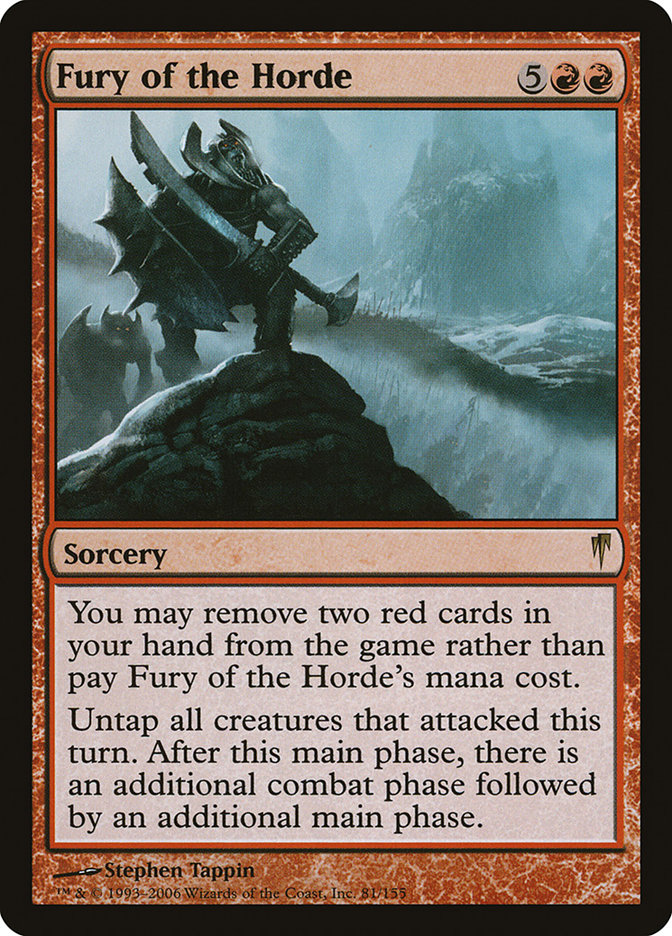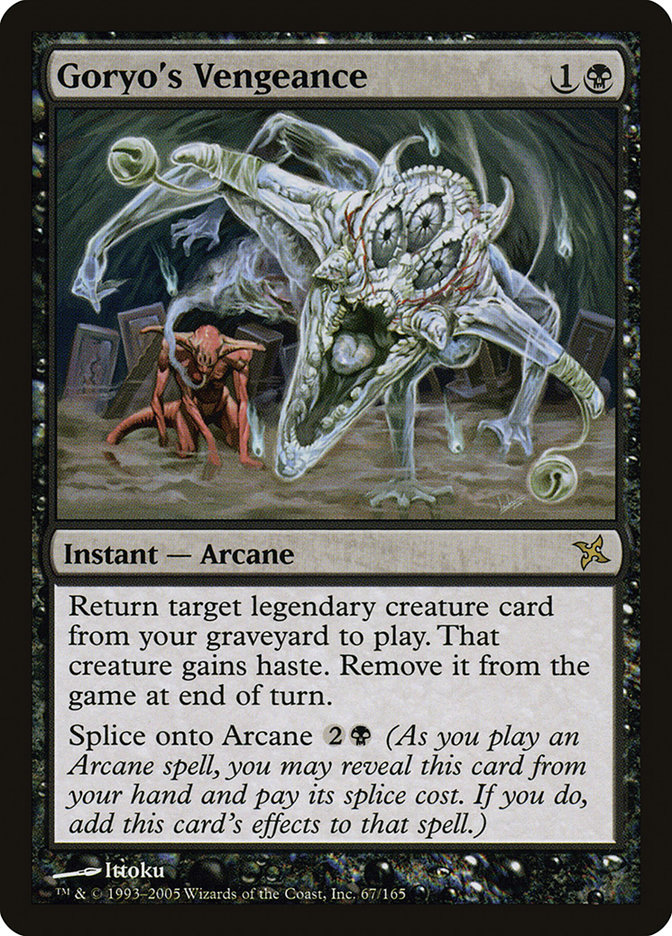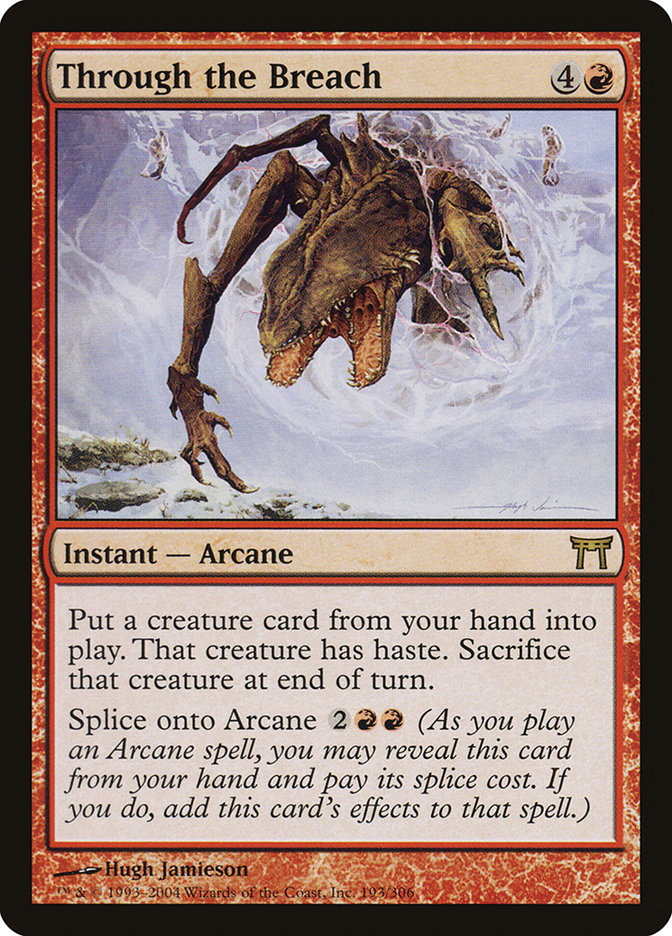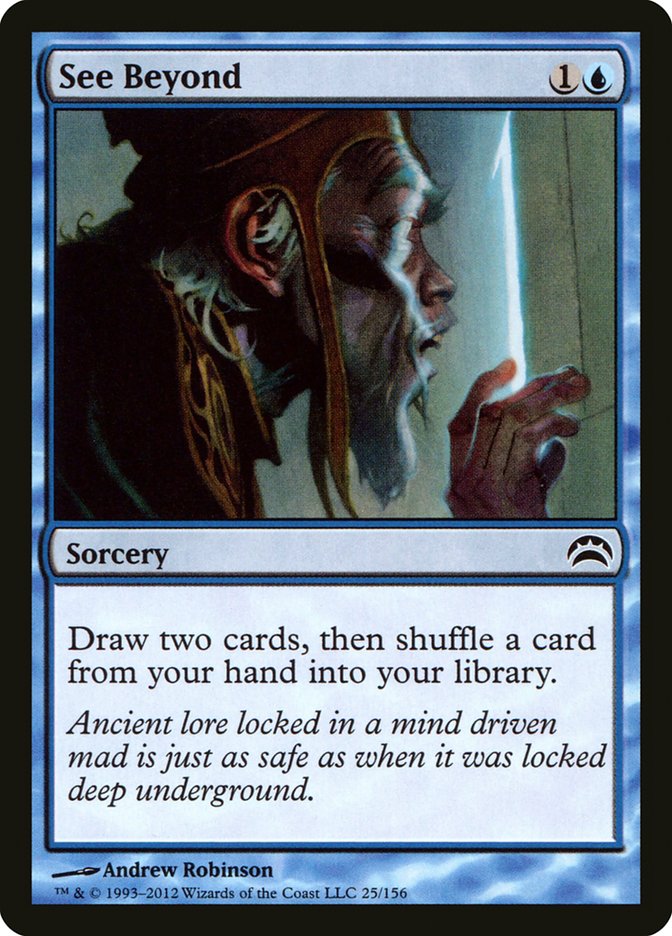Your heart sinks a little. Looking down at the opponent’s board full of creatures that seem to be four times bigger than yours, you gulp. His hand is still full of cards while you stare at the top of your deck, waiting for something. Anything to help you get out of this mess. You draw another land and can’t help but sigh. As you extend the hand, you try to recall different points in each game, looking for an alternate route to victory. What could you have done differently? Would it have changed the outcome of the match?
As you pull your hand back from a half-hearted congratulations, you notice it’s clammy with a cold sweat. You grimace, wondering why your opponent was sweating so much, when you realize the sweat is yours. And then you balk at the realization that your tournament is over, and it is all you can do to keep from screaming at your opponent. After all, you should have won the game after he missed that on-board kill.
This is how I used to feel after every match of Magic that I lost.
But you didn’t win. You didn’t deserve to win because you aren’t special. Your draw wasn’t good enough, or you made a mistake that you can’t see, or sideboarded poorly, or just built your deck incorrectly. Or you played the wrong deck. Something you did had to have affected the outcome of that match. How could it not?
Sometimes there isn’t actually anything you could have done differently. Sometimes someone else wins the tournament with the same deck as you because of a million different factors. There is so much randomness in Magic and in life that you can’t accurately predict what is going to happen. All you can do is try to reduce the variance in any given game of Magic to give yourself the best possible chance to win the tournament.
As I write this article, I am still unsure of what deck I want to play at Grand Prix Richmond. For one, the tournament is going to be gigantic, and I fully expect the cap of 5,000 players to be reached. With a Grand Prix of that magnitude and the current number of rounds capped at fifteen, that means a significant number of players will miss Top 8 with a record of 13-2. This means that in order to lock up Top 8, you must go 13-1-1, which is an absolutely absurd record for any tournament, let alone a Grand Prix.
What this tells me is that one person out of all of those hopeful souls is going to need to get extremely lucky and also play perfectly in order to win. I want to be that lucky person, so I have to figure out how to give myself the best chance possible to actually win the tournament. If you want to win, you must take into consideration all the variables—what cards you’re going to play against, the different decks out there, matchup percentages—and ultimately come up with an answer that leads to playing the best deck for the metagame.
But metagames, especially of this magnitude, are absurdly hard to predict and never predicted perfectly. There will always be outliers, and you will play against those outliers quite often. With that in mind and a tournament this large coming to my doorstep, I’ve decided that it’s probably a reasonable bet to just throw all logic out the window.
What if for this one tournament you had to play a deck or play out certain matches with the expectation that, yes, you are the one who needs to get lucky to win. You can put a powerful strategy in your own hands and then roll the dice.
Right now, I’m hoping for boxcars. Or, more accurately, Yahtzee.
When I registered for Pro Tour Born of the Gods, I needed to make Top 25 in order to lock up Silver in the Pro Players Club for the rest of the season, effectively qualifying me for the next three Pro Tours. With that goal in my head, I decided that I wanted to play a low-variance deck that had decent matchups. Zoo was the obvious conclusion at the time because it seemed like drawing reasonably well would help accumulate the necessary wins for Top 25 (assuming I could hold my own in the Limited portion). I opted to spend most of my time theorizing on how to build the best Zoo deck and used the remaining time preparing for Limited.
At the end of testing, I was comfortable in both formats and ready to do well, though I knew my deck could easily lose if my draws weren’t up to par. I had to get a little lucky to get my desired record, but I also learned something about myself.
If I’m not playing to win the tournament, then something inside me systematically shuts down.
I can see it in the mirror at every single tournament I go to. When I’m out of contention for Top 8, I stop focusing as much on the right play. Hell, I even stop randomizing my opponent’s deck after every shuffle, opting for the easier "give it a cut" route. I give up a little and resign myself to the boredom that comes for playing for less prize than first place. It’s a depressing feeling to see yourself . . . to feel yourself break down mentally.
I’m not sure if this is a natural occurrence or something that is inherently wrong with my work ethic, but I have a defeatist attitude even when there is still potential to win a big prize. I should have known going into the Pro Tour that expecting to do "all right" instead of "incredibly well" was a recipe for disaster. Losing is not something I’m okay with, but it is just another part of the game that you have to come to accept.
But this is something entirely different. Just thinking about playing a deck that is basically a coin flip to shoot itself in the foot every other round is absurd, right? Well, for Grand Prix Richmond, you need to go big or go home. There is literally no room to mess around because a second loss is death. This is a fifteen-round PTQ where first place . . .
Well, you know what first place gets. But second place?
Set of steak knives.
So if an absurd record is necessary in this fifteen-round tournament, I think being conventional sounds like a losing proposition. I’m breaking the "gentlemen’s agreement" and just killing people on turn 2 all day every day.
In case you haven’t heard of this deck by now, the combo goes like this:
1. Put Griselbrand into play, preferably with haste.
2. Attack.
3. Draw a bunch of cards.
4. Cast Fury of the Horde for free.
5. Rinse.
6. Repeat.
There are at least three ways I know of that allow you to cheat Griselbrand into play with haste.
Interestingly enough, both halves of Breaking // Entering actually work well in the deck. In the early turns of the game, using Breaking to mill yourself for eight cards can be pretty awesome, effectively hitting Griselbrand a large percentage of the time. If you already have Goryo’s Vengeance in hand, then that’s just gravy.
However, if you don’t have Goryo’s Vengeance in hand, Breaking is just a glorified Faithless Looting that doesn’t actually dig deeper into your deck. The best way to mitigate this is by playing some number of Snapcaster Mage so that you give yourself more virtual copies of Goryo’s Vengeance as well as a mini Lightning Bolt package to help defend against an early creature rush.
For reference, here is a list similar to what I played in a Modern Daily Event yesterday:
Creatures (12)
Lands (20)
Spells (28)
- 4 Goryo's Vengeance
- 4 Lightning Bolt
- 4 Pentad Prism
- 4 Fury of the Horde
- 4 Faithless Looting
- 4 Izzet Charm
- 4 Breaking
Sideboard

As you can see, this deck can do some interesting things alongside being able to kill the opponent on turn 2. With Lightning Bolt and Izzet Charm, you can buy yourself a lot of time against decks full of annoying creatures. Alongside Snapcaster Mage, you actually have a nice little removal package.
For the most part Breaking // Entering is going to be milling, but alongside Pentad Prism and Simian Spirit Guide it can act as another way to help get your Griselbrand on the battlefield. The kicker is that if you can’t kill your opponent that turn, your Griselbrand doesn’t even die, unlike Through the Breach and Goryo’s Vengeance. Fusing the spell is just a tad overkill but has happened before with draws that feature double Pentad Prism. Obviously eight mana is a lot, but sometimes you gotta do what you gotta do.
This version of the deck is more susceptible to graveyard hate pre-board, but the good news is that Deathrite Shaman is gone forever, so we aren’t exactly expecting to face off against a ton of Jund. Scavenging Ooze randomly shows up in other green decks, but hopefully we can take care of that with a Lightning Bolt or Izzet Charm before any creatures get into the graveyard.
After board if we expect some amount of graveyard hate, Through the Breach is an absurd alternative. I’ve played versions with Through the Breach in the maindeck (which we’ll talk about in a moment), and they are quite powerful, albeit a little slow. There are certainly merits to having a consistently quick kill in the maindeck and having the more expensive win condition in the sideboard. After all, the likelihood of facing off against any real maindeck graveyard hate is pretty low. No one is coming to the party with Relic of Progenitus or Grafdigger’s Cage in their maindeck, and there are no incentives like Helm of Obedience to play Rest in Peace.
With that in mind, we’re gumming up a lot of sideboard slots with the Breach combo. If our opponent is a control deck with actual graveyard hate, it can be very difficult to bust through a single piece of disruption. Through the Breach is an expensive Magic card and one that I’m not too keen on getting hit with Dispel. The way this board is set up, we don’t actually have a good way to prevent ourselves from losing to Grafdigger’s Cage and the like because we just don’t have enough room to fight what we need to fight. This is one of the reasons why I like this version of this deck just a little bit better.
Creatures (12)
Lands (20)
Spells (28)

Thisversion is a lot more powerful and a lot less susceptible to graveyard hate due to the Through the Breach in the maindeck. With Emrakul, the Aeons Torn hanging out with Griselbrand, we have a higher threat density, giving us fewer draws that leave us stuck with a single combo piece in hand. The Breaking // Entering version has a reasonable chance to just whiff on finding a Griselbrand to put into play, and starting more copies of gigantic monsters helps to mitigate that. Your goldfish draws in a deck like this need to be able to kill the opponent quickly, as most decks won’t have too many ways to interact with you favorably in the first game. If you can’t assemble the combo in time, you’re just going to die to Wild Nacatl and friends.
Hilariously enough, Thoughtseize can act as a discard outlet for your fatties while also doubling as potent disruption. Taking away their early counterspell or Path to Exile or just slowing down whatever combo they’re trying to assemble is awesome, but you have to find the balance between preventative disruption and card selection, which is why we’re only playing two in the maindeck. I’ve toyed with all sorts of enablers and dig spells, but the best one for me has been See Beyond.
While some people will immediately cut this card from the deck, I urge you to give it a try. You will find that many draws include copies of extra fatties or Fury of the Horde, neither of which you always want to discard (ala Emrakul, the Aeons Torn shuffling your entire graveyard back into the deck). See Beyond gives you a way to dig for combo pieces or hit land drops while shuffling those useless cards back into your deck so that you can draw them later when you actually need them.
Discarding copies of Fury of the Horde early in the game is an easy way to lose when you’re trying to combo off. You usually need two copies of Fury of the Horde to kill the opponent with Griselbrand, occasionally more if they’re able to gain a few points of life.
This deck has two sides to it that you need to be constantly aware of. The Goryo’s Vengeance plan is all about filling up your graveyard in a hurry, making Faithless Looting and Izzet Charm strong assets. The fact that they are both red for Fury of the Horde also helps the deck function smoothly. However, Through the Breach requires a lot of mana, and looting effects are an easy way to run out of resources in a hurry. See Beyond doesn’t net you any actual card advantage, but you effectively break even while getting rid of something useless. It’s one of the best cantrips available for Through the Breach style decks, though I will admit that it does look mediocre on paper.
Serum Visions is something I’ve tried out in place of See Beyond before, but I don’t know if it is necessarily better. It just feels far too slow when you’re digging for your combo while under pressure, whereas See Beyond does almost exactly what you want it to do at all points in the game. Others have suggested Wild Guess, which I don’t necessarily hate, but the fact that you have to discard a card as an additional cost is pretty miserable if they counter it. If you’re trying to combo with Emrakul, the Aeons Torn, then discarding as an additional cost is absurdly bad since you’re often using those cantrips to find a Goryo’s Vengeance and the trigger for Emrakul will resolve before your Wild Guess.
I want to try out a number of different cards and potential strategies for this type of shell, as I think that Goryo’s Vengeance and Griselbrand is possibly the strongest combo in Modern. It allows for some completely busted draws and can regularly kill the opponent on turn 2 (occasionally through disruption). Just like any graveyard deck, the problem comes when the opponent has access to disruption for your graveyard and can also interact with Through the Breach, whether it’s Thoughtseize or some sort of counterspell. I think that Defense Grid and Boseiju, Who Shelters All help out with the latter of those two problems, and hopefully you’ll just be able to fight through the discard effects.
The main problem with counterspells is that they effectively Time Walk you and sometimes worse. Often you will need a Simian Spirit Guide or Pentad Prism to cast Through the Breach, and a single counterspell, even a Remand, can set you back multiple turns. This is why I think that having Defense Grid or Boseiju, Who Shelters All is incredibly important, though I don’t know if you actually need access to both. The current control decks can kill you out of nowhere quite abruptly thanks to Snapcaster Mage, Lightning Bolt, and even Celestial Colonnade or Restoration Angel. While you spin your wheels looking for combo pieces, they have all the time in the world to play their threats on your turn. This also turns Boseiju into a potential liability thanks to the loss of life.
When your combo requires life to go off efficiently thanks to Griselbrand, cards like Boseiju, Who Shelters All and Thoughtseize become much worse. Add to this the fact that your mana base usually deals you a few points of damage and you could have a recipe for disaster. This leads me to believe that something like Pact of Negation could be a bit better than either of these cards, though it’s obviously narrow and potentially dangerous. Pact of Negation is effective protection for all-in style combo decks like this but is particularly situational, and there are many situations where it doesn’t do anything at all. At the very least, I don’t think maindecking it would be all that useful, but more testing is required to find out.
Slaughter Pact is another sweet addition to the sideboard, mostly to help out against Splinter Twin. Half of their combo interacts favorably with your game plan, as your creatures are required to have attacked if they are to be untapped with Fury of the Horde. I fully expect them to tap your creature and then immediately go for the combo kill. After all, you’re tapped out, so why wouldn’t they?
Before the change to the legend rule, having them tap down your threat was incredibly awkward because you couldn’t just put another copy of your legend into play and keep comboing. Regardless of whether or not you’ve attacked, Fury of the Horde will still give you additional combat phases, meaning that you can keep attacking with a fresh Griselbrand or Emrakul now that the legend rule has changed.
This is particularly important to note, as you will almost always want to use your combo pieces during the end of your opponent’s turn so that you have access to enough mana to combo again during your own turn. Both Through the Breach and Goryo’s Vengeance have the clause that the creature will die at the beginning of the next end step, meaning you can bring the fight to their door and hopefully creating a window on your own turn to kill them.
If you want to try out some of the wackier ideas I’ve had with the archetype, you should take a look at this list.
Creatures (10)
Planeswalkers (3)
Lands (22)
Spells (25)

Perhaps this deck is a bit too ambitious (even for me), but it does have a lot of sweet interactions. One major problem is probably the fact that the deck doesn’t have any sort of Life from the Loam engine, which works well in conjunction with Liliana of the Veil, Necrotic Ooze plus Borborygmos Enraged, and Zombie Infestation. You also have some sweet cards to mill over with Dredge, such as Lingering Souls and Unburial Rites.
Overall, this deck is very cute but not great. I’m not a strong enough deckbuilder to know how to fix this kind of a monstrosity. Obviously, some aspect needs to be cut from the deck in order to make it function more smoothly. I have a hunch that Smallpox isn’t as good as I think it is or would be much better when you aren’t trying to hit four mana for Necrotic Ooze.
At the very least, this list could give you something to think about.
There is so much potential in Modern to use your graveyard to your benefit, and with Deathrite Shaman gone, this could be a great time to experiment. I for one love putting Griselbrand into play, but I’m surprised more Life from the Loam decks haven’t started to pop back up. With Abrupt Decay being an absurd card in the current Modern format, I feel like a G/B/x shell could be very powerful given the right pilot and right deckbuilder.
Modern is shaping up to be a truly fantastic format full of unique strategies that all seem to have their own identity. Luckily, most of them fold to dealing 21 damage and drawing your whole deck on turn 2.







